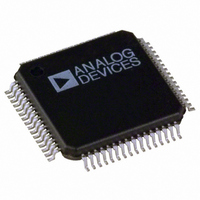ADE7166ASTZF8 Analog Devices Inc, ADE7166ASTZF8 Datasheet - Page 112

ADE7166ASTZF8
Manufacturer Part Number
ADE7166ASTZF8
Description
IC ENERGY METER 1PHASE 64LQFP
Manufacturer
Analog Devices Inc
Specifications of ADE7166ASTZF8
Applications
Energy Measurement
Core Processor
8052
Program Memory Type
FLASH (8 kB)
Controller Series
ADE71xx
Ram Size
512 x 8
Interface
I²C, SPI, UART
Number Of I /o
20
Voltage - Supply
3.135 V ~ 3.465 V
Operating Temperature
-40°C ~ 85°C
Mounting Type
Surface Mount
Package / Case
64-LQFP
Ic Function
Single Phase Energy Measurement IC
Supply Voltage Range
3.13V To 3.46V, 2.4V To 3.7V
Operating Temperature Range
-40°C To +85°C
Digital Ic Case Style
LQFP
No. Of Pins
64
Lead Free Status / RoHS Status
Lead free / RoHS Compliant
Available stocks
Company
Part Number
Manufacturer
Quantity
Price
Company:
Part Number:
ADE7166ASTZF8
Manufacturer:
Analog Devices Inc
Quantity:
10 000
Company:
Part Number:
ADE7166ASTZF8-RL
Manufacturer:
Analog Devices Inc
Quantity:
10 000
ADE7566/ADE7569/ADE7166/ADE7169
Mode 2 (8-Bit Timer/Counter with Autoreload)
Mode 2 configures the timer register as an 8-bit counter (TL0)
with automatic reload as shown in Figure 97. Overflow from TL0
not only sets TF0 but also reloads TL0 with the contents of TH0,
which is preset by software. The reload leaves TH0 unchanged.
Mode 3 (Two 8-Bit Timer/Counters)
Mode 3 has different effects on Timer 0 and Timer 1. Timer 1 in
Mode 3 simply holds its count. The effect is the same as setting
TR1 = 0. Timer 0 in Mode 3 establishes TL0 and TH0 as two
separate counters. This configuration is shown in
TL0 uses the Timer 0 control bits, C/ T , Gate0 (see Table 103),
TR0, TF0 (see
function (counting machine cycles) and takes over the use of
TR1 and TF1 from Timer 1. Therefore, TH0 controls the Timer 1
interrupt. Mode 3 is provided for applications requiring an
extra 8-bit timer or counter.
When Timer 0 is in Mode 3, Timer 1 can be turned on and off
by switching it out of and into its own Mode 3, or it can be used
by the serial interface as a baud rate generator. In fact, Timer1
can be used in any application not requiring an interrupt from
Timer 1 itself.
GATE
P0.6/T0
f
INT0
CORE
f
CORE
P0.6/T0
f
CORE
GATE
INT
TR1
/12
0
TR0
Table 104), and
TR0
C/T = 1
C/T = 0
Figure 97. Timer/Counter 0, Mode 2
Figure 98. Timer/Counter 0, Mode 3
C/T = 0
C/T = 1
CORE
CLK/12
CONTROL
CONTROL
INT0
RELOAD
(8 BITS)
(8 BITS)
(8 BITS)
TH0
TL0
(8 BITS)
TH0
. TH0 is locked into a timer
TL0
TF1
TF0
TF0
Figure 98.
INTERRUPT
INTERRUPT
INTERRUPT
Rev. A | Page 112 of 144
TIMER 2
Timer/Counter 2 Data Registers
Timer/Counter 2 also has two pairs of 8-bit data registers
associated with it: Timer 2 High Byte SFR (TH2, 0xCD), Timer
2 Low Byte SFR (TL2, 0xCC), Timer 2 Reload/Capture High
Byte SFR (RACP2H, 0xCB), and Timer 2 Reload/Capture Low
Byte SFR (RACP2L, 0xCA). These are used as both timer data
registers and as timer capture/reload registers (see
Table 113).
Timer/Counter 2 Operating Modes
The following sections describe the operating modes for
Timer/Counter 2. The operating modes are selected by bits in
the Timer/Counter 2 Control SFR (T2CON, 0xC8), as shown in
Table 105 and Table 114.
Table 114. T2CON Operating Modes
RCLK (or) TCLK
0
0
1
X
16-Bit Autoreload Mode
Autoreload mode has two options that are selected by Bit EXEN2
in Timer/Counter 2 Control SFR (T2CON, 0xC8). If EXEN2 = 0
when Timer 2 rolls over, it not only sets TF2 but also causes the
Timer 2 registers to be reloaded with the 16-bit value in both the
Timer 2 Reload/Capture High Byte SFR (RACP2H, 0xCB) and
Timer 2 Reload/Capture Low Byte SFR (RACP2L, 0xCA)
registers, which are preset by software. If EXEN2 = 1, Timer 2
performs the same events as when EXEN2 = 0 but adds a 1-to-0
transition at external input T2EX, which triggers the 16-bit
reload and sets EXF2. Autoreload mode is shown in
16-Bit Capture Mode
Capture mode has two options that are selected by Bit EXEN2
in Timer/Counter 2 Control SFR (T2CON, 0xC8). If EXEN2 = 0,
Timer 2 is a 16-bit timer or counter that, upon overflowing, sets
Bit TF2, the Timer 2 overflow bit, which can be used to generate
an interrupt. If EXEN2 = 1, Timer 2 performs the same events
as when EXEN2 = 0 but adds a l-to-0 transition on external
input T2E, which causes the current value in the Timer 2 registers,
TL2 and TH2, to be captured into the RCAP2L and RCAP2H
registers, respectively. In addition, the transition at T2EX causes
Bit EXF2 in T2CON to be set, and EXF2, like TF2, can generate
an interrupt. Capture mode is shown in Figure 100. The baud
rate generator mode is selected by RCLK = 1 and/or TCLK = 1.
In either case, if Timer 2 is used to generate the baud rate, the TF2
interrupt flag does not occur. Therefore, Timer 2 interrupts do not
occur and do not have to be disabled. In this mode, the EXF2 flag
can, however, still cause interrupts that can be used as a third
external interrupt. Baud rate generation is described as part of the
UART serial port operation in the
CAP2
0
1
X
X
TR2
1
1
1
0
UART Serial Interface section.
Mode
16-bit autoreload
16-bit capture
Baud rate
Off
Figure 99.
Table 110 to













